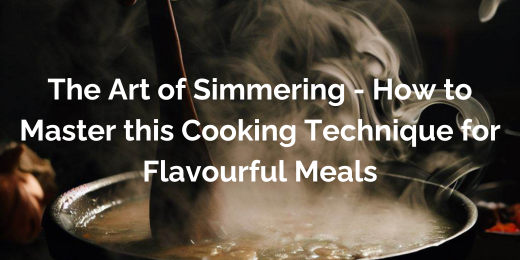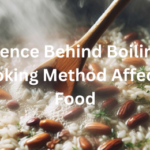Mastering the simmering technique
Simmering is a vital cooking technique that involves gently cooking food in liquid at a low temperature. Mastering this technique is crucial for crafting tantalizing and flavourful meals. By simmering ingredients slowly, their flavours harmonize, resulting in delectable dishes. Simmering is especially beneficial for tougher cuts of meat, as it tenderizes them by breaking down connective tissues.
Nurturing your relationship with what you cook, soups, stews, and sauces benefit greatly from simmering, developing robust and complex flavours. Simmering’s versatility extends beyond savoury dishes; it can infuse fruits, create syrups, and poach delicate seafood. Embrace the art of simmering to elevate your culinary creations and embark on a journey of exquisite taste experiences.
Understanding Simmering
Simmering is a cooking technique characterized by gently heating food in a liquid just below its boiling point. Mastering the simmering technique involves achieving and maintaining this delicate balance of heat. Unlike boiling, which involves vigorous bubbling and higher temperatures, remember that what you eat is what you are, simmering requires a lower, more controlled heat.
The ideal temperature range for simmering typically falls between 180°F (82°C) and 205°F (96°C). At this temperature, the liquid produces small, gentle bubbles that break the surface without a rolling boil. Simmering allows ingredients to cook slowly, allowing flavours to meld together and intensify while keeping the texture of the food tender. It is important to maintain this gentle simmer to ensure the desired results in your culinary creations.
Essential Tools and Ingredients
Mastering the simmering technique requires the right tools and ingredients. When it comes to tools, a sturdy, heavy-bottomed pot or pan is essential to ensure even heat distribution. A lid is crucial to trap steam and maintain a consistent simmer. Utensils such as a long-handled spoon or ladle are handy for stirring and skimming any impurities that rise to the surface.
As for ingredients, simmering is often used for dishes that include meats, vegetables, and legumes. Common ingredients include chicken, beef, onions, carrots, potatoes, and beans. To achieve the best results, it’s important to select high-quality ingredients. Opt for fresh produce, well-marbled meats, and flavourful stocks or broths. Using fresh herbs and spices can also elevate the taste profile of your simmered dishes.
Mastering the Simmering Technique
In the culinary world, mastering the simmering technique is crucial for achieving delicious and flavourful dishes. To help you become a simmering expert, here is a step-by-step guide. Firstly, explore different methods such as stovetop simmering, slow cooker simmering, and oven simmering. Each method offers unique benefits and can elevate the taste of your recipes, much like saute cooking techniques. Secondly, to maintain the ideal simmering conditions, remember to use a low heat setting, ensuring that the liquid remains below its boiling point.
Additionally, using a heavy-bottomed pan or pot can distribute heat evenly, preventing scorching or uneven cooking. Lastly, expert tips include occasionally stirring the ingredients, adding liquid as needed, and covering the pot to retain moisture. By following these steps and incorporating these expert tips, you’ll soon become adept at the art of simmering.
Flavourful Meals through Simmering
The simmering technique opens up a world of culinary possibilities, allowing you to create a wide range of delectable dishes. Let’s explore some recipes that truly shine when prepared using this method. Savoury options like hearty stews, tender braised meats, and flavourful soups benefit from the slow and gentle simmering process. The low heat allows the ingredients to meld together, resulting in rich and complex flavours.
On the sweet side, simmering can transform simple fruits into luscious compotes and jams, infusing them with natural sweetness and preserving their vibrant colours. Creamy rice puddings and silky custards are also perfect candidates for simmering, as the slow cooking gradually thickens and enriches their textures. Whether you prefer savoury or sweet, mastering the simmering technique will unlock a world of culinary delights.
Tips and Tricks for Success
In addition to mastering the simmering technique, there are key tips and tricks that can enhance your kitchen skills. Firstly, select suitable ingredients for simmering, such as meats rich in collagen that tenderize beautifully through slow cooking. Secondly, unleash your creativity by experimenting with herbs, spices, and aromatics to impart tantalizing flavours to your dishes. Remember to season and taste along the way for optimal results.
Avoid the common mistake of boiling the liquid vigorously, as it toughens meats and diminishes appeal. Instead, maintain a gentle simmer by adjusting the heat accordingly. Lastly, embrace versatility by using simmered meats in sandwiches or transforming leftover simmered vegetables into delectable frittatas. Incorporate these ideas to elevate your everyday cooking with the mastery of the simmering technique.
Conclusion
Mastering the simmering technique is a game-changer in the culinary realm, offering a multitude of benefits that can transform your meals from ordinary to extraordinary. Simmering allows for the gentle release of flavours, resulting in dishes that are rich, aromatic, and deeply satisfying. By taking the time to simmer ingredients, you unlock the potential for tender meats, infused broths, and perfectly cooked vegetables.
We encourage you to embrace the art of simmering and explore the vast world of simmered dishes. From classic comfort foods to innovative creations, the possibilities are endless. So, grab your favourite ingredients, adjust the heat to a gentle simmer, and let the magic unfold in your kitchen. Start simmering your way to flavourful meals and discover the joys of this essential culinary technique. Bon appétit!



